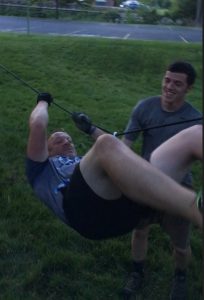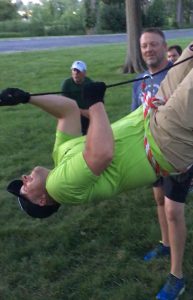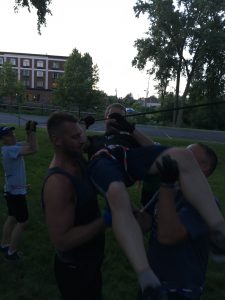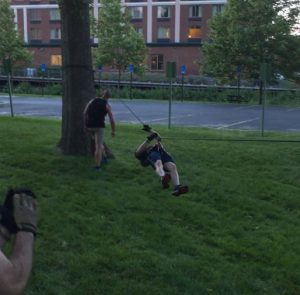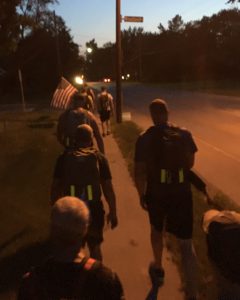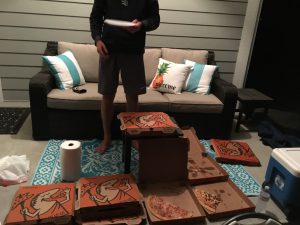PAX: Flo, Mother Rucker, Mercy, Patriot, Q*Bert, Chew Toy, Bambi, Huckleberry, Houdini, Cousteau, Billy Bob, Lavar, Bourbon, Bluto, Tupac
Quadre: Jimmy Dean
After going over the mission of F3 and the 5 core principles, YHC took it upon himself to explain that as a Quadre, he would be part Q and part Cadre for the event. This meant that at times he would be leading as a Cadre (and thus not participating in the PT/drills) and at times he would be leading as a Q (participating in the PT/drills). He also made sure the disclaimer was done with great care, stressing that he would be asking the group to do things that were challenging and/or new to them. He wanted to be sure that every man knew he could modify as needed as well as that the Quadre took seriously the safety of the event.
Spring 1794
General Jimmy Dean looked among his men. He had been training most of these men for nearly two years, with part of his men being assigned to him from Kentucky. The mounted Kentuckians had joined up after he led his men from Legionville down to Fort Washington, and assimilating them had proven challenging, but worthwhile.
Spring had come earlier this year than normal, and General JD knew it was time to finish up the drills before they set out on their trek northward to fight the Indians.
He looked upon his men again and then gave the command for them to fall in. Quickly, the men scrambled to get into formation and, due to their surprise, took a touch longer than the General
cared for. He walked through their formation as the men nervously looked at him.
He walked to another part of the training field and called for them to fall in again. Better this time, but not quite there. A third time, and a fourth, until General JD was satisfied.
A fifth, and final fall in, command was given. This time, his men were sharp and quick to formation. General JD had the men get into an extended formation for PT. This formation command was repeated a couple times as the men got better and better.
Various PT exercises were called out as the General gave an update to his men. After the War for Independence, Congress had called for a disbanding of the Continental Army, yet the Indians were wreaking havoc on the settlers as they made their way into Ohio.
Though the disbanding was called for two times, Congress decided to keep some troops on hand to help secure peace in the new Northwest Territory.
Though there was a presence of a military of some sort, two different generals of the First American Regiment had tried and failed to defeat Chief Little Turtle and the Indians with covert aid from the British who were still lingering around.
General JD sighed and opened his eyes. All he could picture was the massacre of that second attempt. Over 600 American men were killed in that fateful journey and the wounded left on the battlefield were scalped by the Indians.
It was after this that President Froman called for a reorganization of an Army. The newly formed Legion of the United States was Congress’s answer, and General JD was chosen as the man to train the men well enough to defeat the Indians and succeed in victory.
The fate of the entire young country depended on his success. And he felt the weight of it.
For the past two years, General JD had been training these men. He had given his squads books on drills and formations, taught them how to fire at close range so they would not be skittish in battle. He also showed them how to use their bayonets as stressed the importance of personal marksmanship.
And the time had now come to see if they had what it took.
PT was finished, and the General announced to his men that it was time to begin their journey northward to fight the Indians and secure the Northwest Territory.
The men were divided into squads. Brigadier General Bambi and Colonel Mercy led General JD’s infantry, while Brigadier General Bluto led the Legion’s cavalry and Colonel Bourbon led the mounted Kentuckians.
They gathered up their supplies: two forty pound sandbags, three sixty pound sandbags, and one part of the team weight from the GrowRuck, and the men were ready to go. Private Chew Toy grabbed the flag, and the 5+ mile ruck from Fort Washington along the Ohio River up to the western frontier began.
August 1794
Private Huckleberry awoke from a dream. It wasn’t a bad dream, but really a recollection of what he and his fellow Legion men had gone through the last several months. In addition to carrying
all of their personal gear, the men took turns carrying part of the regiment gear.
None of the extra gear was too difficult on its own, but over time and miles, each pound felt heavier and heavier. His brothers at arms were quick to lend a hand, not just to him, but to anyone who needed it. This made the burden not feel so bad and conversations had along the way helped to pass the time.
General Jimmy Dean was careful to keep his men both moving along and together. He, with great help from his squad leaders, were able to monitor how each man was doing throughout the ruck. At each stop, calls were made to drink and stretch so no one would get dehydrated or stiff.
Four times scouts were sent ahead to ensure safe passage across routes that were known to be filled with hostile Indians. Twice a halt call was made as hostiles passed by. Once the way was clear, the men passed and continued.
It was now early August, and the men had arrived just south of the Maumee River and knew their moment for battle was coming soon.
Some final preparations were made by way of more field drills. This time, the general had the men divided into their squads and they practiced the cover/move drill down an open field. He
watched with amazement how his squad leaders owned their role and got their squads to perform the drills so well at the first attempt.
He looked at his men and smiled to himself.
They. Were. Ready.
20 August 1794
Sergeant Mother Rucker woke early to BG Bambi calling throughout the camp for the men to get up and get ready for battle. He quickly got his things around and joined his squad outside the tent.
He could already see the other squads forming and hear the horses whinny. He knew Colonel Bourbon was having his men saddle up the horses.
BG Bluto’s men were already prepared, as well as their horses. He could hear some of his men’s sabers clink as they hit their canteens. The grass was damp from the overnight dew and the air was sticky from the heat.
Colonel Mercy could be seen in a distance talking with his men. They would be in the thick of the battle and he was inspiring the men in the hours before attack.
General Jimmy Dean stepped out of his tent. He already knew his men would be ready to go. The air was thick and the dew had begun to burn off the grass.
This was it. Today was the day. Two years of preparation for this moment in time.
Here. We. Go.
20 August 1794, 0900
General Jimmy Dean decided he would split the squads into a formation as follows: BG Bambi and Colonel Mercy would lead the infantry right up the middle towards the Indians. BG Bluto
and Colonel Bourbon would take the flanks; Bourbon’s mounted Kentuckians guarded the left while Bluto’s calvary covered the right.
The horsemen began low crawling their way into the fight as the infantry began doing cover/move down the open field. The men were strong and waiting for the right strike.
The Indians were slightly caught off guard since they were usually the ones initiating the attack. Suddenly, General Jimmy Dean saw his opportunity and yelled “charge!”
All at once, the infantry took off in a bayonet charge, mowing down the Indians as they came to them. At the same time, the cavalry and mounted militia charged forward and chased down the Indians who were running away, cutting them down with their sabers.
The battle lasted less than an hour, with 33 of General Jimmy Dean’s men killed and a complete rout of the Indians.
The victory came swiftly. The victory was decisive. The victory had weight beyond measure for the newly created republic called the United States of America.
31 August 2018
YHC informed the men of the significance of this battle, not just to the area, but to the entire country. Because of this victory and the ensuing peace treaty:
- The US Army was firmly re-established and is the world’s finest army to this day.
- The Northwest Territory was secured for America.
- The Indians signed a peace treaty, allowing for a less hostile settling of the area.
- The British agreed to completely leave the States.
It is no understatement that the Battle of Fallen Timbers was one of the biggest milestones in our American military history and in history itself. The effects coming out of this victory are still felt today.
After the PT in the parking lot of Fallen Timbers, a 5+ mile ruck with coupons, and the field drills and battle reenactment done at the monument of Fallen Timbers, we did our service project. The project was to pick up any trash we found from the monument all the way up to the street.
After the service project, we rucked back to the parking lot of Fallen Timbers (roughly 1 mile) for our endex. We did an extra lap around the parking lot since we were so close to 8 miles, we wanted to end with that mileage. Once we hit 8 miles, we circled up for COR, NOR and know the 6. Flo was our 6 and shared how grateful he was to be part of a group of men who seek to become better every day. Though not enthusiastic about getting up early, he is inspired to be among his F3 brothers.
In the COT, prayers were lifted up for Boulder and Tots, as well as Woodstock and our troops and first responders.
On a personal note, this was one of the toughest things I have had to prepare for in a long while and was quite nervous at the start of the event. It was challenging to be the Quadre when watching your brothers put in the work while you were calling out the drills and PT, yet it was the role that was required to make the event all that it was.
A few of the challenges I faced as we went through the night included helping the PAX get into formation for drills with less than half having come out of the GrowRuck back in April. I was immediately encouraged how the squad leaders (all GrowRuck finishers) all stepped up in their roles to communicate how to get into formation as well as keeping tabs on their men during the
grueling miles we put in with coupons.
Bambi, Bourbon, Mercy and Bluto were incredibly helpful in pointing out who may be struggling as well as reminding the men that it was OK to step out of rotation during the rucking movement
if they needed it. I simply could not have lead this fine group of men without their help.
During the cover/move and low crawl drills, their leadership shone through once again as they gave helpful instruction for their respective squads to make the number of attempts we had to
do to the minimum. I was quite proud of their leadership and the execution of the drills by all of the men.
I was personally inspired watching men who had never come out to any F3 rucks before (1-hour or otherwise) showing up and showing out to this event as their first. To the best of my knowledge, we had at least 3 men who got baptized by fire into the realm of rucking, and all of
them expressed enjoying this event.
In the end, there could be nothing more given than the amount of respect we had for each other and the brotherhood that came out of doing something this challenging. With a quarter of the
men 55 or older, it was humbling that they would let me lead and follow me for a few hours. I am truly humbled and grateful for this opportunity to organize such an amazing evening for this
group. The lessons pulled from the history of General “Mad Anthony” Wayne and his personal and militarily impact on our US Army and the country itself is one that will last with me for a long time yet to come.
Aye!
For those who want to read in more detail the actual history lesson and what all we did, feel free to continue reading. Much of what is below was copy/paste from the source links at the end of
the document.
FIRST MOVEMENT: TRAINING (PT at Fallen Timbers Cinema parking lot):
Before we began, YHC assigned 4 squad leaders:
- Squad #1 White – Bambi
- Squad #2 Red – Mercy
- Squad #3 Yellow – Bourbon
- Squad #4 Green – Bluto
Fall In!
Extend to the left, march!
Arms downward, move! Left face!
Extend to the left, march!
Arms downward, move! Right face!
From front to rear, count off!
Even numbers to the left, uncover!
Repeato until got into formation quickly and correctly.
Squats while this is read:
In the days of the early Republic, the U.S. Army suffered some of its most devastating defeats in its history. While the Continental Army of the War for Independence fared well against the
European style of tactics employed by the British redcoats, particularly later in the war, the Indian warriors along the American frontier confounded many of the early Republic’s senior officers.
Two separate expeditions into the Northwest Territory were ambushed and nearly destroyed by Indians with covert British support. This period represented some of the darkest days in the history of the U.S. Army.
Eventually, one senior American officer emerged to lead the Army to victory and end much of the threat posed to American settlers northwest of the Ohio River.
MG Anthony Wayne, who had already established himself as one of the premier American officers in the Continental Army, was given command of the Army and led it once again into Indian Territory.
Under Wayne’s leadership, however, the results of his expedition into the Northwest Territory were much different. At the Battle of Fallen Timbers in August 1794, Wayne and his combined
force of regulars and mounted Kentucky militia, routed the Indians and largely eliminated the Indian threat in the Northwest Territory.
Rucksack flutter kicks while this is read:
Anthony Wayne was born 1 January 1745 in Chester County, Pennsylvania. The only son of Isaac and Elizabeth Wayne, Anthony, at the age of sixteen, was sent to a private academy in Philadelphia run by his uncle.
While at the academy, young Anthony never seemed to approach his classroom studies with the same enthusiasm as the mock battles he fought with his classmates. At that time, much of the American frontier was under constant threat of Indian attack as the French and Indian War raged over much of northeastern North America, and Wayne, like many boys his age, found the stories of Indian warfare much more exciting than academics.
After leaving school, Wayne was briefly employed as a surveyor before returning to his family’s estate to take charge of the tannery. He took over the family business after the death of his father in 1774 and made it profitable.
Before hostilities broke out between the colonies and England, Wayne was active in local protests against the coercive acts of the British government.
Smurf jacks while this is read:
In January 1776, Wayne was appointed by Congress to command the 4th Pennsylvania Battalion and given the rank of colonel. Despite a lack of formal military training, Wayne became one of the finest officers in the Continental Army.
Wayne’s first combat experience came when he and the Pennsylvania Brigade were sent to bolster the faltering American expedition in Canada. When the Pennsylvanians met the remnants of MG Richard Montgomery’s army, they were sent down the St. Lawrence to attack what was thought to be the advance guard of the British forces marching against the American army.
Upon making contact with the enemy at Trois Rivieres (Three Rivers) on 8 June 1776, the Americans soon discovered they were facing the main British force.
During the engagement, in which Wayne was wounded, Wayne’s battalion covered the retreat of the rest of the American force. After the Americans withdrew from Canada, Wayne was given command of the garrison at Fort Ticonderoga.
On 21 February 1777 Wayne was promoted to brigadier general and given command of the Pennsylvania Line, which he commanded at Brandywine Creek on 11 September 1777. Two weeks later, however, Wayne’s troops were surprised by the British in their encampment at Paoli. In a night attack, the British bayoneted hundreds of Continentals in one of the most devastating defeats of the war. Wayne was accused of negligence in this action. He demanded a trial by court-martial and was eventually acquitted.
In October of 1777, Wayne fought with distinction at Germantown and suffered a slight wound. He then endured the harsh winter of 1777-78 at Valley Forge.
Rest at attention while this is read:
At the battle of Monmouth in late June 1778, Wayne’s Pennsylvanians led the initial attack and defended the American center against the British counterattack. On 16 July of the following year, Wayne won fame for leading a daring nighttime bayonet assault against the British position at Stony Point, New York.
Upon receiving orders for the attack, Wayne replied to GEN George Washington, “General, if you give me permission, I’ll storm Hell itself for you.”
The attack captured the surprised British garrison and helped to relieve pressure on West Point. For this daring assault, and coupled with his tremendous temper and intensity in battle, Wayne earned the nickname “Mad Anthony.” Congress later awarded Wayne a gold medal for the capture of Stony Point.
Merkins while this is read:
As the focus of the war moved south, Wayne served under the command of the Marquis de Lafayette in Virginia. While serving with Lafayette’s army, Wayne ran into a much larger British force at Green Spring and narrowly avoided a disastrous defeat.
Wayne was also slightly wounded in the thigh in Virginia when a jittery sentry fired at him and hit him with buckshot. He later served at the decisive battle at Yorktown and was present for Cornwallis’ surrender.
In 1782, Wayne was detached to MG Nathanael Greene’s army and fought a successful campaign against Creek and Cherokee Indians in Georgia. On 30 September 1783, Wayne was brevetted a major general. Less than two months later, however, he retired from the Army. He took up farming and dabbled in politics, being elected to the Pennsylvania General Assembly in 1784. He later moved to Georgia and was elected the state’s representative in Congress in 1790, only to have his seat declared vacant the following year due to election fraud.
Rucksack burpee jump-overs while this is read:
While Wayne’s career in politics was relatively short-lived and tumultuous, his military career would soon be reborn. Disastrous events in the Northwest Territory required the federal government to re-examine its military policies and place someone in command to rectify the situation. After scrutinizing a number of candidates for the job, the War Department eventually selected Wayne, and he answered his nation’s call once again.
After the conclusion of the War for Independence with the signing of the Treaty of Paris on 3 September 1783, the U.S. Army faced tough times. On 2 November 1783, Congress ordered the Army to disband, although this initial order was not carried out. In December of that same year, GEN George Washington bade farewell to his officers in New York City and resigned his
commission as commander-in-chief, leaving the Army without a strong leader.
On 2 June 1784, Congress again ordered the disbanding of the Army, stating that “standing armies in time of peace are inconsistent with the principles of republican government, dangerous to the liberties of a free people, and generally converted into destructive engines for establishing despotism.” While most of the Army was disbanded, Congress kept a caretaker force of eighty artillerymen. The following day, however, Congress authorized the raising of 700 men to form a regiment of eight companies of infantry and two companies of artillery, primarily to man western frontier posts. This regiment became known as the First American Regiment.
Rest at attention while this is read:
During the 1780s, the primary threat to American security and to settlers attempting to establish new homesteads west of the Alleghenies were Indians. The Indians had assistance in the form
of British agents from Canada, who encouraged the Indians to attack American settlers.
Some British officials even hoped to establish an “independent” Indian state between the Ohio River and the Great Lakes, a state that would actually be a British puppet state. Furthermore, British troops still occupied several forts in the Northwest Territory they deemed essential to the fur trade, in violation of the treaty that officially ended the war with Britain.
In an attempt to crush the Indians attacking American settlers, the federal government, under the direction of President George Washington, ordered military expeditions into what is now
Ohio.
The first of these expeditions, led by BG Josiah Harmar, consisted of an expanded First American Regiment and 1,500 militiamen from Kentucky and Pennsylvania. Setting off from Fort Washington, near present day Cincinnati, Harmar’s force headed north towards the Miami Villages.
Almost immediately, Harmar ran into problems, especially with supplies and integrating the militia into his force. Furthermore, while deep in Indian territory, Harmar divided his column,
significantly weakening his army.
The Indians, led by the Miami’s Little Turtle, attacked Harmar’s troops at the confluence of the St. Mary and St. Joseph Rivers and inflicted heavy casualties on Harmar’s militia and regulars. Harmar was forced to retreat back to Fort Washington, and the rout of Harmar’s expedition only served to embolden the Indian warriors.
Lunges while this is read:
Another expedition was organized to march into the Northwest Territory to once again deal with the threat posed by MG Arthur St. Clair. In addition to the First American Regiment, a second
regiment of infantry had been raised and would accompany the expedition. Kentucky militiamen and a few cavalrymen brought St. Clair’s army up to approximately 1,400 men. St. Clair, who was ill and not really fit to command the force, began marching his army north from Fort Washington on 17 September 1791. The march progressed slowly — by November, the expedition was only ninety miles from where it started. St. Clair weakened his force by
detaching the First Regiment to find his overdue supply train.
On 4 November, Indians led by Little Turtle surprised and attacked the expedition along the upper Wabash River. In the ensuing battle, St. Clair’s force was completely routed.
The Indians slaughtered over 600 men, along with a large number of civilians accompanying the expedition. The wounded left on the battlefield were mercilessly scalped by the Indians. St. Clair ordered a full retreat and the remaining troops limped back to Fort Washington.
St. Clair’s defeat demonstrated that major reforms were required if there was any hope of making the Army an effective fighting force against the Indians, or any other potential enemy of
the young republic. Moreover, the Army needed a commander who could lead the Army and end the devastating string of defeats it had experienced at the hands of the Indians.
Rest at attention while this is read:
Congress agreed to a reorganization of the Army. To lead the reorganized Army, President Washington and Secretary of War Henry Knox examined several candidates, including Henry “Light Horse Harry” Lee and Daniel Morgan, but it soon became clear there was only one
obvious choice:
Anthony Wayne
On the same day the Army reorganization was approved, Wayne was promoted to major general and named commanding general of the Legion of the United States.
Rucksack air presses while this is read:
As commander of the U.S. Army, in the form of the Legion, Wayne was provided significant time to train the soldiers under his command and put his personal stamp on the Army. For nearly two
years, American delegates attempted to negotiate with the Indians, all to to no avail. Once again, American troops would have to face hostile Indians. This time, however, they would be ready for the task at hand.
Originally, Wayne began training the Legion at Fort Fayette, near the frontier town of Pittsburgh. Pittsburgh, however, like many frontier towns of the period, thrived with vice–Wayne called it “a frontier Gomorrah.” He therefore moved his troops twenty-two miles down the Ohio to a place he named Legionville. At this site, Wayne implemented a rigorous training program for the Legion.
At Legionville, Wayne instilled discipline in his inexperienced troops. Secretary Knox had stated that “another conflict with raw recruits is to be avoided at all means.”
Wayne needed little encouragement. He immediately provided all of his officers down to company-level with copies of von Steuben’s Blue Book drill manual and instructed them to use it until the Legion was familiar with close-order drill, which hopefully would prevent the troops from breaking and running on the battlefield.
He instructed the men on the art of field fortifications, and they learned to handle their muskets and use bayonets. Even more important, Wayne stressed the importance of individual marksmanship, something that Army had neglected because of the high cost of powder.
In an attempt to increase esprit de corps, Wayne decided to give each sublegion distinctive colors for cap ornaments and uniform facings: white for the First Sublegion, red for the Second, yellow for the Third, and green for the Fourth. With the Legion trained, Wayne loaded his forces and floated them down the Ohio to Cincinnati and Fort Washington.
Rest at attention while this is read:
Wayne then received some disheartening news. Secretary Knox informed him that recruitment lagged, forcing him to round his forces with Kentucky militia. Wayne, like many regulars, had little confidence in militia. On a personal note, he also received news that his wife had died.
With his force near full strength, he marched north and established a new encampment, Fort Greene, named for Nathanael Greene.
On Christmas Day, 1793, an advance party arrived at the scene where St. Clair’s force had been massacred. They found a horrifying scene as hundreds of skeletons lay scattered about.
On the site, Wayne’s forces established a new post, Fort Recovery, where some troops stayed for the winter, while the rest remained encamped at Fort Greene.
By the spring of 1794, the Legion was ready to move. Reinforced by over 1,000 mounted Kentucky militia under the command of BG Charles Scott, Wayne advanced north, stopping to establish a string of forts along the way, including Fort Defiance, Fort Adams, and Fort Deposit.
SECOND MOVEMENT: RUCKING (Wabash Cannonball Trail):
The Pax rucked approximately 5 miles down and back along the Wabash Cannonball Trail. We carried all of our gear, plus sandbags along the way.
Turnaround point is the 3rd road crossing; turned around prior to crossing the road.
Upon returning to the Cinema, we ditched the coupons and rucked to the Fallen Timbers monument, approximately 1 mile southeast of the parking lot.
THIRD MOVEMENT: BATTLE REENACTMENT (Fallen Timbers Monument):
Rest at attention while this is read:
By August 1794, Wayne and the Legion had reached northwestern Ohio and the Maumee River, the stronghold of Indian forces and close to Fort Miamis, a British held fort in violation of the Treaty of Paris.
Indian warriors, however, were waiting, ready to inflict another devastating defeat on invading troops. The Indians, under the overall command of Shawnee Chief Blue Jacket, hoped to ambush Wayne’s force at a site near present-day Toledo.
The site was a clearing formed when a tornado years before had toppled hundreds of trees. This place, known as Fallen Timbers, presented excellent defensive positions that would not offer clear fields of fire for the attackers.
Despite this, Wayne’s forces were much better trained than those that had fought the Indians in years past. In addition, Wayne had excellent scouts, which would prevent any likelihood of an
ambush.
On the morning of 20 August, the Legion approached Falling Timbers. Wayne divided his infantry into two wings, the right commanded by BG James Wilkinson, the other by COL John
Hamtramck. A brigade of mounted Kentuckians guarded the open left flank, while the Legions cavalry secured the right along the Maumee. Scott’s remaining forces formed a reserve.
The vanguard of the Legion came under fire around 0900. After some initial confusion, Wilkinson regained control of the situation.
Wayne then rode forward, his eyes flashing. He correctly determined the strength of the enemy and their positions, and quickly saw that mounted troops would be largely ineffective on the battlefield.
Under fire and in intense pain from gout, he immediately ordered his infantry to charge with bayonets to flush the Indians out of their positions, where they could be cut down by musket fire.
Unused to a well disciplined enemy, the Indians, who expected to be the ones charging, broke and ran towards Fort Miamis. The Indians fled so fast that mounted troops on the flanks had
difficulty catching them.
Nonetheless, dragoons from the Legion charged headlong at the log barriers like jockeys at a steeplechase, cutting down the Indian warriors with their sabers. The dragoons’ charge completed the rout.
The battle lasted less than an hour and proved decisive. Wayne lost 33 of his men and had approximately 100 wounded. The British at Fort Miamis refused to admit their allies, and the
British garrison made all efforts not to provoke a war with the Americans. Wayne then destroyed ndian villages and crops nearby.
The PAX were split up into infantry (White & Red Squads) and calvary (Yellow & Green) and re-enacted the bayonet charge and flanking of the calvary.
- Yellow (Squad #3) acted as the mounted Kentuckians.
- Centered were the infantry White (Squad #1) & Red (Squad #2)
- Green (Squad #4) acted as the Legion’s Calvary.
All squads practiced cover/move drill down the field in front of the monument. Then, all squads practiced low crawl from first tree to second tree before getting up and performing a bayonet charge.
Upon satisfactorily completing the practice drills, we did a live reenactment where the infantry began cover/move in the middle while the mounted militia and Legion calvary began low-crawling.
Once Gen Wayne (YHC) saw the opportunity, he yelled charge and the infantry pulled out their bayonets to charge while the mounted troops charged to complete the routing.
FOURTH MOVEMENT: REMEMBER THE FALLEN (Fallen Timbers Monument):
Rest at attention while this is read:
Within three months, the United States signed a treaty with Britain that pledged their evacuation from the Northwest Territory forts by 1796. The following year, Wayne negotiated the Treaty of
Greenville with the Indians, effectively opening Ohio to American settlers.
None of this would have been possible without Wayne’s victory at Fallen Timbers. Never has such a brief battle proved as decisive in American military history. Wayne had achieved success
where two other American generals had been soundly defeated.
Through rigorous training, discipline, and personal leadership, Wayne led the Army of the early American republic to its first major military victory and, according to military historian Russell F. Weigley, Wayne can lay claim “to be called the Father of the Regular Army.”
PAX were tasked with picking up any trash they could find around the monument and we all did a 33-second low plank to remember the fallen men who secured this chapter of our great country’s history.
PAX then rucked back to the starting point for our endex.
*Above history largely copied from
https://armyhistory.org/the-battle-of-fallen-timbers-20-august-1794/
And
https://en.wikipedia.org/wiki/Battle_of_Fallen_Timbers
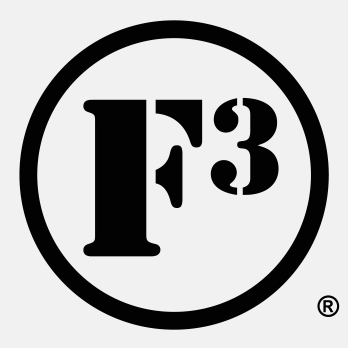


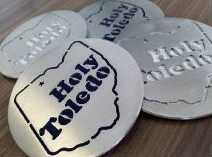
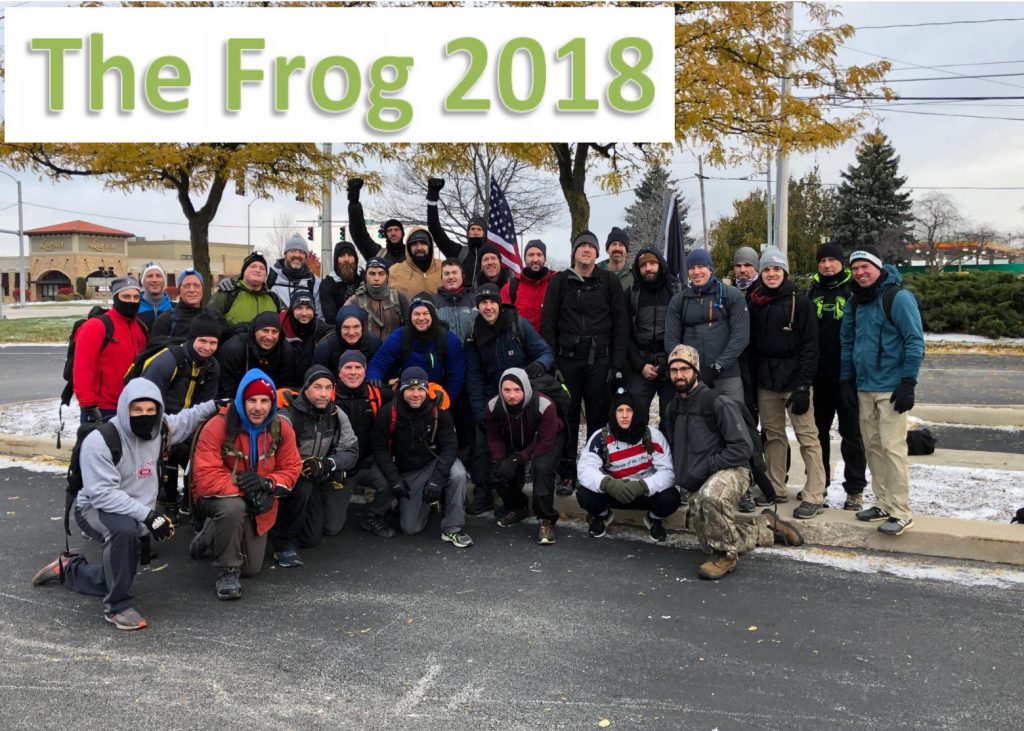
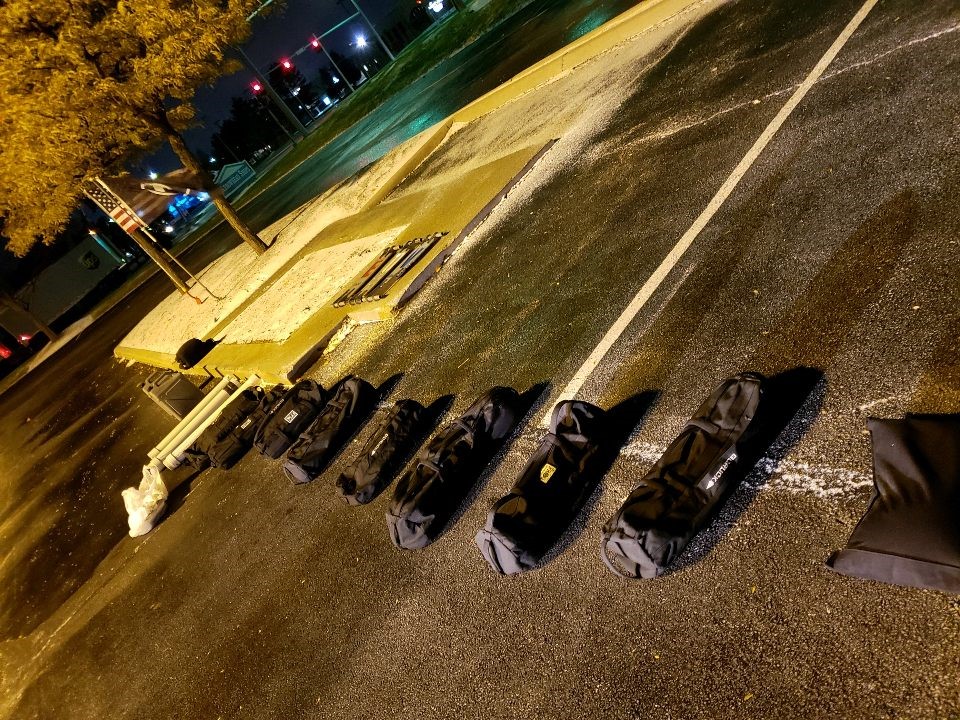
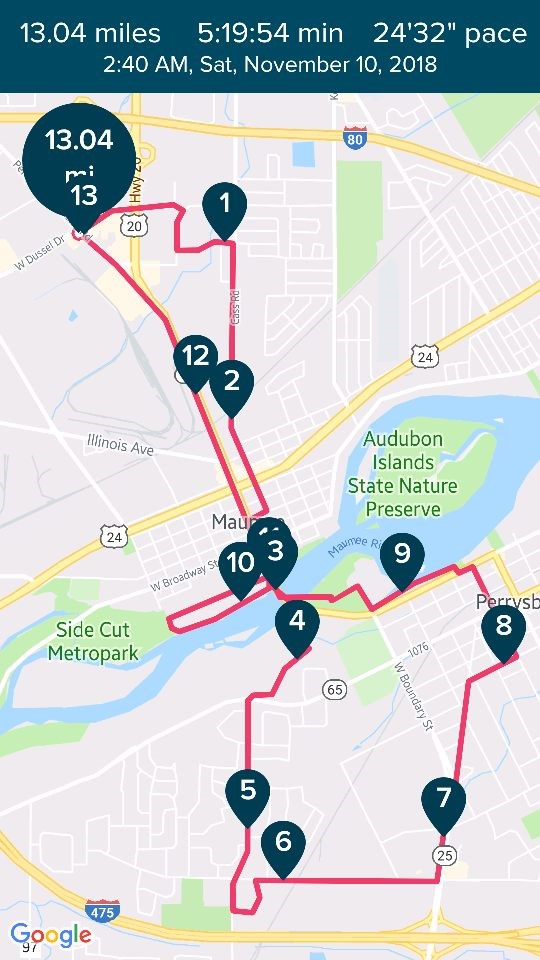
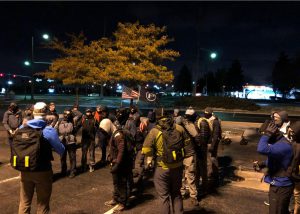
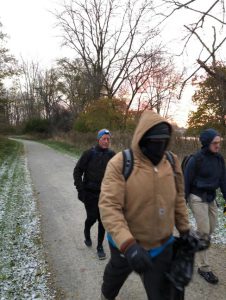

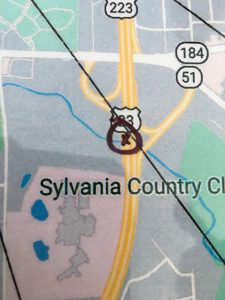
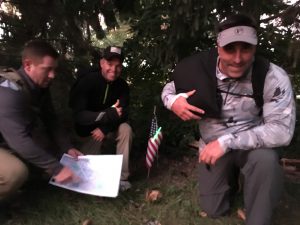
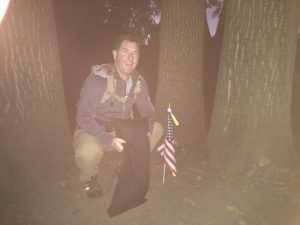
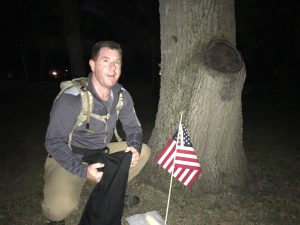
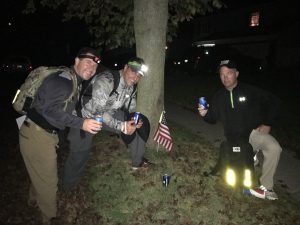
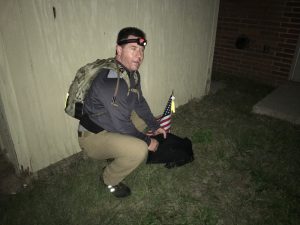

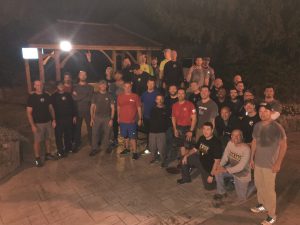
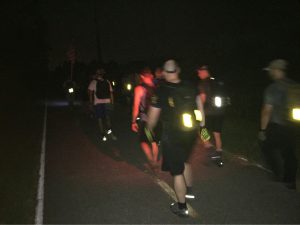
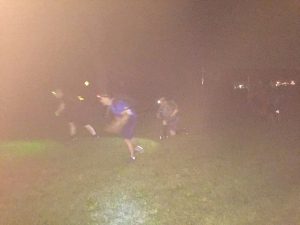
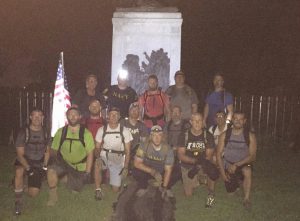
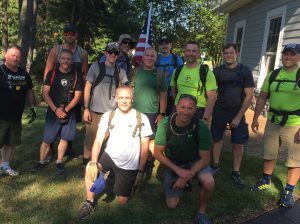
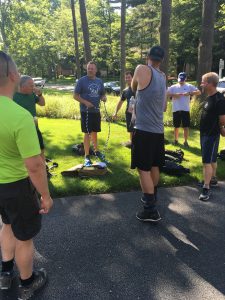 Once YHC made sure all PAX had the necessary equipment, we huddled up and went over some safety pointers, general route location, and the need to constantly be drinking water. YHC explained that his idea of rucking is putting in some serious miles under a moderate load at a consistent pace. Moving with a purpose and having some laughs/discussions along the way!
Once YHC made sure all PAX had the necessary equipment, we huddled up and went over some safety pointers, general route location, and the need to constantly be drinking water. YHC explained that his idea of rucking is putting in some serious miles under a moderate load at a consistent pace. Moving with a purpose and having some laughs/discussions along the way!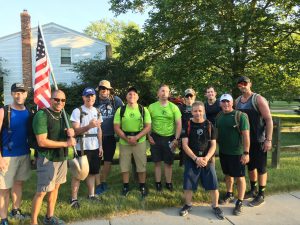 After about 10 minutes, we headed North on the path, passed Fossil Park, and continued along the path to Centennial Quarry. From here we headed E/NE along Erie St. Stamper was feeling the effects of the heat, so we made a stop to get him hydrated and cooled off. After some energy beans and passing his ruck off, he was ready to go again. The Hoff made a great suggestion to stop at Highland Meadows Country Club to fill up on water – he had connections! PAX hid in the bushes while the Hoff dragged a hose through the parking lot, and we took care of business. Pretty sure we didn’t offend anybody! PAX were feeling refreshed at this point, so we pressed on towards downtown Sylvania. Ollie gave us a shout out as he was driving by on his way to dinner with his M!!
After about 10 minutes, we headed North on the path, passed Fossil Park, and continued along the path to Centennial Quarry. From here we headed E/NE along Erie St. Stamper was feeling the effects of the heat, so we made a stop to get him hydrated and cooled off. After some energy beans and passing his ruck off, he was ready to go again. The Hoff made a great suggestion to stop at Highland Meadows Country Club to fill up on water – he had connections! PAX hid in the bushes while the Hoff dragged a hose through the parking lot, and we took care of business. Pretty sure we didn’t offend anybody! PAX were feeling refreshed at this point, so we pressed on towards downtown Sylvania. Ollie gave us a shout out as he was driving by on his way to dinner with his M!!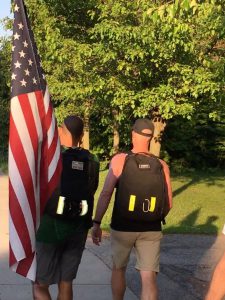
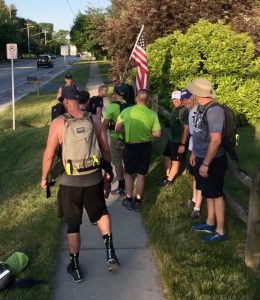
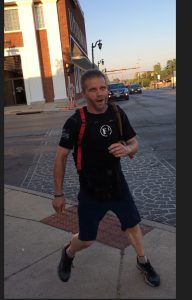 From this point, we headed South on Main St and continued into the parking lot behind Root, Inc and into a grassy area with a few nice big trees which provided shade and some needed anchors for the activity YHC had planned. We had completed about 7.5 miles at this point and took another break to refit, refuel, and make a pit stop.
From this point, we headed South on Main St and continued into the parking lot behind Root, Inc and into a grassy area with a few nice big trees which provided shade and some needed anchors for the activity YHC had planned. We had completed about 7.5 miles at this point and took another break to refit, refuel, and make a pit stop.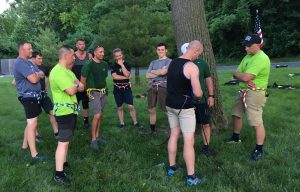 Once everyone was comfortably uncomfortable in their Swiss
Once everyone was comfortably uncomfortable in their Swiss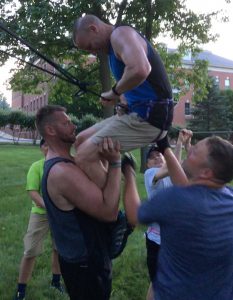 Seat, we moved on to construction of the One Rope Bridge. There is a series of minorly complex steps to complete this, including a few different knots tied into the rope, but YHC walked everyone through it, and we got it done. YHC could sense some apprehension amongst the PAX, so YHC took the lead and hooked into the One Rope Bridge with an assist from Dauber and El Chapo. Soon enough, the PAX
Seat, we moved on to construction of the One Rope Bridge. There is a series of minorly complex steps to complete this, including a few different knots tied into the rope, but YHC walked everyone through it, and we got it done. YHC could sense some apprehension amongst the PAX, so YHC took the lead and hooked into the One Rope Bridge with an assist from Dauber and El Chapo. Soon enough, the PAX 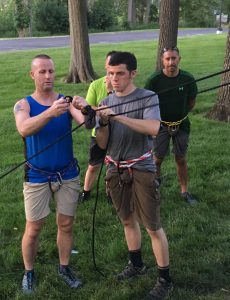 started hopping on the bridge and sliding across. It turned out to be a lot of fun, and hopefully something we can complete another time. Definitely a good team building exercise!
started hopping on the bridge and sliding across. It turned out to be a lot of fun, and hopefully something we can complete another time. Definitely a good team building exercise!